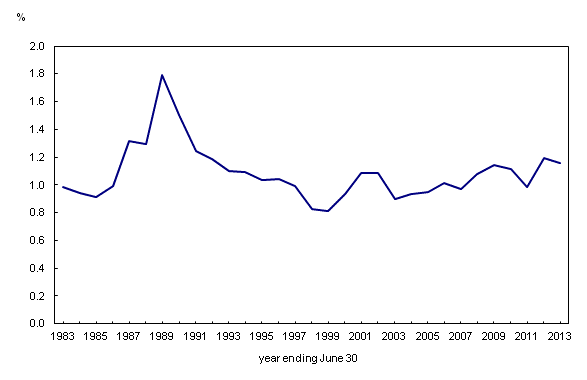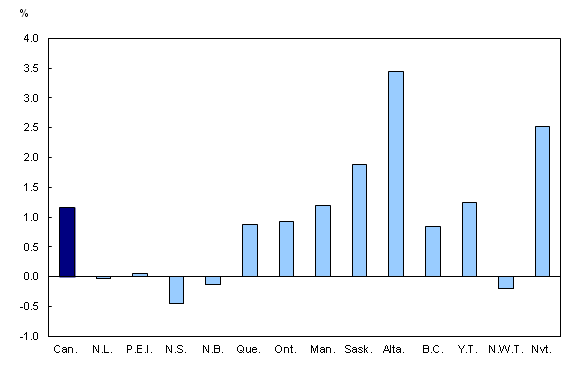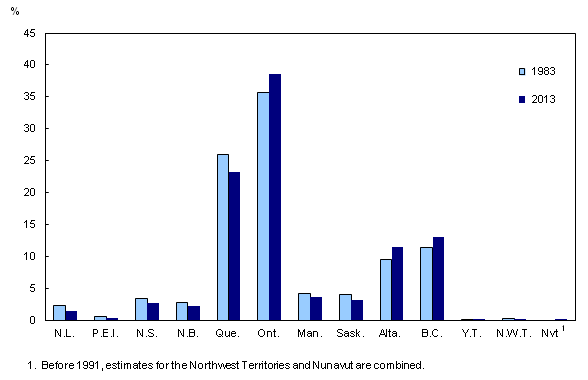Canada's total population estimates, 2013
Archived Content
Information identified as archived is provided for reference, research or recordkeeping purposes. It is not subject to the Government of Canada Web Standards and has not been altered or updated since it was archived. Please "contact us" to request a format other than those available.
Released: 2013-09-26
On July 1, 2013, Canada's population was estimated at 35,158,300, up 404,000 (+1.2%) over the last year. This increase was equal to the one observed from July 1, 2011, to July 1, 2012, and similar to the average annual gains for the last 30 years (+1.1%).
Except for the period between 1986 and 1990, the population growth rate has shown little variation in 30 years, ranging from 0.8% to 1.2%. Population estimates released today are now based on the 2011 Census counts adjusted for census net undercoverage and incompletely enumerated Indian reserves.
Between 2006 and 2011, Canada's population growth rate (+5.3%) was the highest among the G8 countries. Population growth for other G8countries ranged from a 0.8% decline in Germany to a 3.4% gain in the United States and the United Kingdom. Among industrialized countries, Canada's population growth fell below the estimated rates for countries such as Luxembourg (+8.7%), Ireland (+7.8%) and Australia (+7.6%).
Since 1993/1994, net international migration has been the main source of population growth for Canada. From July 1, 2012, to July 1, 2013, it was responsible for two-thirds of the country's population growth.
Population growth lower in the Atlantic provinces, higher in the West
For the year ending June 30, 2013, population growth was lower in the Atlantic provinces and negative in Nova Scotia (-0.5%), while generally higher in the Western provinces. Growth exceeded the national level (+1.2%) in Alberta (+3.4%), Nunavut (+2.5%) and Saskatchewan (+1.9%).
Record levels of international migration and interprovincial migration to the province explain this growth in Alberta. In the Atlantic provinces, low growth was mainly explained by a low natural increase and interprovincial migration losses, which reached a six-year high.
Population of Ontario growing at almost twice the rate of Quebec
In the last 30 years, the populations of the Prairie provinces and British Columbia combined have grown substantially (+39.5%), while the Atlantic provinces have seen their populations edge up 3.5%. By comparison, Canada's population increased by 32.4% during this period. Since 1983, the population share of the Western provinces has increased by 2.2 percentage points, reaching 31.2% on July 1, 2013, compared with a decrease of 2.3 percentage points for the Atlantic provinces with a population share of 6.7%. In turn, the population of Ontario grew almost twice as rapidly (+39.8%) as that of Quebec (+21.0%) during this period. Among the provinces, Alberta has recorded the strongest growth since 1983, with an increase of 50.8%. Population growth in the territories was 43.5% for the same period. On July 1, 2013, three-quarters of Canadians were living in three provinces: Ontario (38.5%), Quebec (23.2%) and British Columbia (13.0%).
Provincial differences in the intensity of the population growth in the past 30 years can be attributed to several factors. For example, interprovincial migration was generally more favourable to the Western provinces and less favourable to the Atlantic provinces. Natural increase was generally higher in the Prairie provinces and in the territories and lower in the Atlantic provinces. Finally, a greater influx of international migrants was observed in Ontario and British Columbia.
Note to readers
Estimates in this release are based on 2011 Census counts adjusted for census net undercoverage and incompletely enumerated Indian reserves to which is added the estimated demographic growth from May 10, 2011, to June 30, 2013.
The 2011 Census population counts were released on February 8, 2012. Population estimates based on the 2011 Census counts, adjusted for census net undercoverage and incompletely enumerated Indian reserves, will be available in February 2014 for sub-provincial areas.
This release mainly focuses on preliminary postcensal total population estimates as of July 1, 2013. The estimates presented in this release are subject to revision. Future updates could affect the analysis of trends.
Unless otherwise stated, historical comparisons in this analysis relate to the period between July 1, 1971, and July 1, 2013, the period covered by the current system of demographic accounts.
Definitions
Natural increase is the change in population size over a given period as a result of the difference between the number of births and the number of deaths.
Net international migration is the change in population size over a given period as a result of movements of population between Canada and other countries that involve a change in the usual place of residence. A distinction is made between immigrants, emigrants, returning emigrants, net temporary emigrants and net non-permanent residents.
At the provincial and territorial level, population growth results not only from natural increase and net international migration, but also from net interprovincial migration. The net interprovincial migration is the change in the size of a population during a given period as a result of population movements between Canada's provinces and territories, accompanied by a change in usual place of residence.
For a complete and detailed analysis of recent demographic trends, consult The Annual Demographic Estimates: Canada, Provinces and Territories, 2013 (Catalogue number91-215-X), which is now available from the Browse by key resource module of our website under Publications.
Contact information
For more information, or to enquire about the concepts, methods or data quality of this release, contact us (toll-free 1-800-263-1136; 514-283-8300; infostats@statcan.gc.ca) or Media Relations (613-951-4636; statcan.mediahotline-ligneinfomedias.statcan@canada.ca).
- Date modified:




